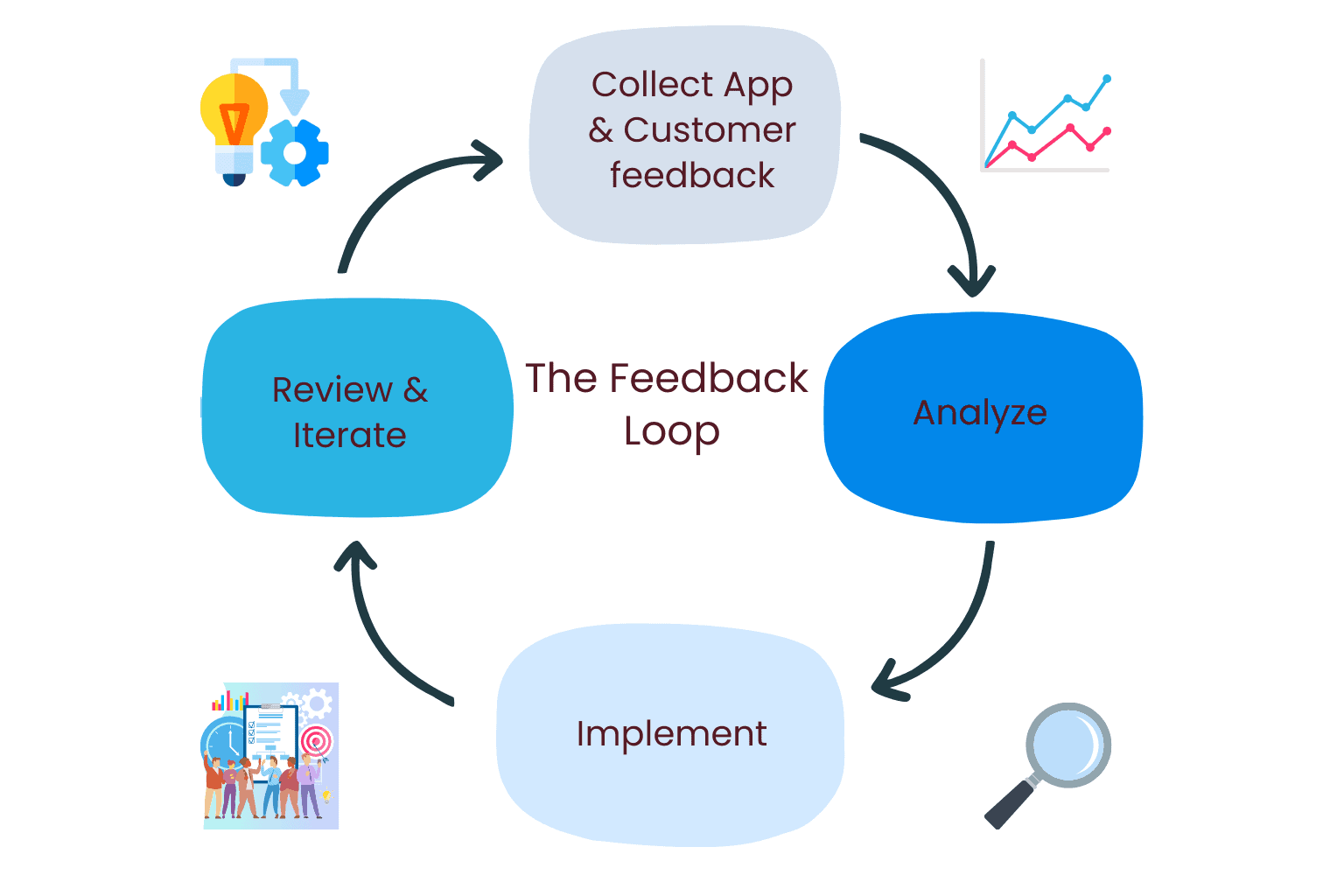Introduction
In the fast-paced app development world, understanding and implementing a robust feedback loop can differentiate between a successful app and one that fails to resonate with its intended audience. A feedback loop helps developers fine-tune their applications based on user input and fosters a deeper connection with the user base by showing that their opinions are valued. Throughout this blog, we will delve into the crucial role of the feedback loop in the app development lifecycle and explore famous use cases where a feedback loop made a significant impact.
Introduction to Feedback Loops
A feedback loop in app development is a system used to gather, analyze, and implement changes based on user feedback. This process allows developers to improve an app, continuously enhancing user satisfaction and engagement. The effectiveness of a feedback loop hinges on its ability to accurately capture the user’s voice and quickly adapt to their needs and preferences, making it a cornerstone of user-centric design and development.
Steps to Implementing an Effective Feedback Loop
Step 1: Collection of Feedback
The first step in creating an effective feedback loop is establishing reliable channels for collecting feedback. This could be through in-app surveys, user reviews on the App Store or Google Play, social media interactions, or direct user testing sessions. The key is to make providing feedback as easy and accessible as possible for users.
Step 2: Analysis of Feedback
Once feedback is collected, the next step in the feedback loop is analysis. Developers and product managers must sift through the feedback to identify common patterns or recurring issues. This analysis helps prioritize which changes or enhancements are most needed and what can be deferred to later development cycles.
Step 3: Implementation of Changes
The core of the feedback loop is turning the insights gained from user feedback into actionable changes. Whether fixing bugs, altering user interfaces, or adding new features, the implementation phase is where the tangible improvements happen. This step requires careful planning and resource allocation to ensure the changes effectively address the users’ needs.
Step 4: Review and Iterate
The feedback loop doesn’t end after changes are implemented. Instead, it’s crucial to review their impact. This can be done by monitoring app performance, user satisfaction, and engagement metrics post-implementation. The feedback loop is a cyclical process meant to be repeated to continually refine and improve the app.
What is Iteration
Iteration is systematically working on a task or project by repeatedly refining and improving it. Each cycle of doing this is called an “iteration.” In the context of app development or any project, Iteration involves:
- Taking an initial idea.
- Creation of a basic version (often called a prototype).
- Testing this version to see how it performs.
Based on feedback and the results of this testing, improvements and changes are made. Then, this process is repeated – the product is refined and tested, and further adjustments are made. Each cycle of this process helps to enhance the product, making it better suited to meet the needs and expectations of its users.
Famous Use Case: Instagram’s Feedback Loop
One of the most notable examples of an effective feedback loop in action is Instagram. In its early days, Instagram used extensive feedback loops to evolve from a simple photo-sharing app to a global social media platform. They regularly released new features and relied heavily on user feedback to refine them. For instance, when Instagram introduced the Stories feature, feedback loops helped them quickly iterate on its functionality, leading to widespread adoption and success.
Slack’s Feedback Loop Use Case
Background: Slack has grown rapidly as a favored communication tool in workplaces worldwide. Its success is primarily attributed to its responsiveness to user feedback, which has been integral since its early development.
Feedback Collection: Slack has multiple channels for collecting feedback from its users. They utilize direct communication within the app, where users can easily send feedback or report issues. Additionally, Slack has a robust presence on social media platforms and professional forums where they actively engage with users and gather input.
Analysis of Feedback: The Slack team continuously analyzes user feedback to understand common issues, desired features, and suggestions for improvements.
Implementation of Changes: Based on this analysis, Slack’s development team implements changes ranging from minor tweaks to major updates. They are known for their rapid iteration cycles, which allow them to quickly develop new features or refine existing ones in response to user input.
Review and Iterate: Slack measures their impact through user engagement and satisfaction metrics after deploying changes. This is a continuous process where the team reviews whether the adjustments have positively addressed users’ concerns. If necessary, further refinements are made to sustain the loop.
Outcome: Slack’s feedback loop played a crucial role in enhancing its notification system. Initially, users reported that managing notifications across multiple channels was cumbersome, which could lead to missed messages or notification overload. By gathering and analyzing user feedback, Slack introduced customized notification settings, allowing users to fine-tune notifications based on their preferences and the channel’s priority. This update significantly improved user satisfaction and helped Slack maintain high engagement levels.

Conclusion
This Slack example illustrates the power of a well-executed feedback loop in adapting to user needs, improving functionalities, and maintaining relevance in a competitive market.
By effectively implementing a feedback loop, developers can ensure that their applications remain relevant and continue to meet their users’ evolving needs. This increases user satisfaction and retention and drives innovation within the app by aligning development goals with actual user expectations and needs.
Remember, a well-maintained feedback loop is not just about fixing what is broken but continually asking, “How can we make this better?” The feedback loop empowers developers to answer this question with precision and agility, making it an indispensable tool in the app development arsenal.

